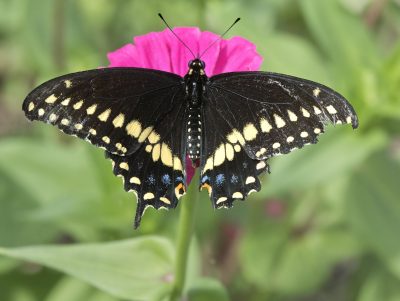
The eastern black swallowtail, Papilo polyxenes asterius is one of the most common swallowtails.
The black swallowtail is found in southern Canada, most of the eastern and mid-western United States to the Rocky Mountains, and in Arizona and northern Mexico.
Females are typically larger than males. The upper surface of their wings is black with two rows of yellow spots which are larger and brighter in males than in females. The area between the rows of spots on the hind wings of females is iridescent blue whereas the blue area in males is less prominent. The under sides of wings in males and females are nearly identical.
Eastern black swallowtail butterflies are generally found in open areas, including wet prairies, fields, woods, pine savannas, roadsides, weedy areas, and gardens.
Eggs are laid singly on new foliage and occasionally on flowers of host plants. Development time varies depending on temperature and host plant species, but usually the egg stage lasts 4-9 days, the larval stage 10–30 days, and the pupal stage 9 to 18 days (except for overwintering pupae). Typically, there are two generations in northern parts of the range and three generations in the south.
All swallowtail larvae have retractable, yellow-orange horn-like organs known as osmeteria which can be displayed when threatened.
A variety of herbs in the carrot family (Apiaceae) including Queen Anne’s lace, wild parsnip, caraway, celery, dill, parsley, and sweet fennel serve as host plants for the black swallowtail butterflies.
Although black swallowtail caterpillars feed on a number of cultivated plants, they are usually not found in sufficient numbers to cause a problem in commercial agriculture. If control is required in home gardens, hand-picking is recommended.
Article by Lynn Keller, DVM